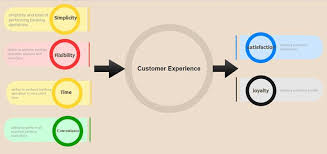Enhancing Customer Experience: The Key to Business Success
In today’s competitive business landscape, providing exceptional customer experience has become a critical differentiator for companies looking to stand out from the crowd. Customer experience encompasses every interaction a customer has with a brand, from the initial contact to post-purchase support. By focusing on enhancing customer experience, businesses can build loyalty, drive repeat business, and ultimately achieve long-term success.
The Importance of Customer Experience
Customers today have high expectations when it comes to the service they receive from companies. They expect seamless interactions, personalised communication, and quick resolutions to any issues they may encounter. A positive customer experience not only leads to increased customer satisfaction but also results in higher retention rates and positive word-of-mouth referrals.
Strategies for Enhancing Customer Experience
There are several strategies that businesses can employ to enhance customer experience:
- Personalisation: Tailoring products and services to meet the individual needs and preferences of customers can create a more engaging and memorable experience.
- Omni-channel Support: Providing consistent support across multiple channels, such as phone, email, chat, and social media, ensures that customers can reach out in their preferred way.
- Proactive Communication: Keeping customers informed about order status, product updates, or upcoming promotions demonstrates care and builds trust.
- Feedback Mechanisms: Encouraging feedback from customers allows businesses to understand their needs better and make improvements accordingly.
- Ease of Use: Simplifying processes, such as checkout procedures or account management, reduces friction points and enhances overall satisfaction.
The Role of Technology in Customer Experience Enhancement
Technology plays a crucial role in enhancing customer experience. From AI-powered chatbots for instant support to data analytics for personalisation strategies, businesses can leverage technology to streamline processes and deliver more meaningful interactions with customers. By investing in the right tools and platforms, companies can gain valuable insights into customer behaviour and preferences, allowing them to tailor their offerings accordingly.
In Conclusion
Enhancing customer experience is not just about meeting expectations; it’s about exceeding them. By prioritising customer satisfaction at every touchpoint and implementing strategies that focus on personalisation, communication, feedback, and ease of use, businesses can create lasting relationships with their customers and drive sustainable growth in the long run.
Understanding Customer Experience Enhancement: Key Concepts and Strategies
- What is experience enhancement?
- What are the 5 C’s of customer experience?
- What are the 4 P’s of customer experience?
- What is the CEM strategy?
What is experience enhancement?
Experience enhancement refers to the process of improving and enriching the interactions and engagements that customers have with a brand or business. It involves creating a more seamless, personalised, and enjoyable experience for customers at every touchpoint, from initial contact to post-purchase support. By focusing on experience enhancement, businesses aim to exceed customer expectations, build loyalty, and foster long-term relationships that drive customer satisfaction and business success.
What are the 5 C’s of customer experience?
The 5 C’s of customer experience are a framework that businesses can use to enhance and improve their interactions with customers. These 5 C’s include: Customer-Centricity, which focuses on putting the customer at the heart of all business decisions; Consistency, ensuring that every interaction with the customer is uniform and aligned with the brand’s values; Convenience, making it easy for customers to engage with the business through various channels; Communication, maintaining open and transparent dialogue with customers to build trust and loyalty; and Customisation, tailoring products, services, and experiences to meet the individual needs and preferences of each customer. By incorporating these 5 C’s into their customer experience strategy, businesses can create meaningful connections, drive satisfaction, and foster long-term relationships with their customers.
What are the 4 P’s of customer experience?
The 4 P’s of customer experience refer to the key elements that businesses should focus on to enhance and deliver exceptional customer experiences. These include Product, Price, Place, and Promotion. Product refers to the quality and relevance of the products or services offered to customers. Price involves setting competitive prices that provide value for customers while ensuring profitability for the business. Place relates to the accessibility and convenience of purchasing channels for customers. Promotion encompasses marketing efforts that communicate the brand’s value proposition and engage customers effectively. By strategically addressing these 4 P’s, businesses can create a holistic customer experience that drives satisfaction and loyalty.
What is the CEM strategy?
The Customer Experience Management (CEM) strategy is a comprehensive approach that businesses adopt to improve and enhance the overall experience of their customers across all touchpoints. It involves understanding customer needs and preferences, mapping out customer journeys, and implementing strategies to deliver consistent, personalised, and seamless interactions. By focusing on CEM, companies aim to build strong relationships with customers, increase satisfaction levels, drive loyalty, and ultimately differentiate themselves in the market. A well-defined CEM strategy encompasses various elements such as customer feedback analysis, employee training, technology integration, and continuous improvement initiatives to ensure that every aspect of the customer experience is optimised for maximum impact.






